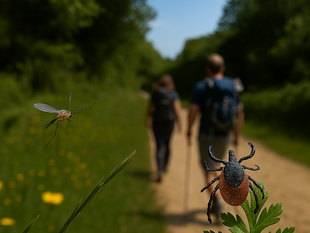La Casa de la Abuela Boticaria

Your Socks Matter More Than You Think on the Camino
jul 14
3 min de lectura
1
20
0
When a pilgrim prepares to walk the Camino de Santiago in the summer, they usually think about boots, the backpack, the walking stick, the credential... but often forget the smallest item. And that small item can make the biggest difference between reaching Santiago or giving up: socks.
Yes, socks. The layer that separates your skin from your shoes, absorbs—or traps—sweat, cushions each step—or causes pain. This is not a minor detail: it’s one of the foundations of comfort and prevention on the Camino.

Why are socks so important?
Your feet will walk 20 to 30 kilometers a day, for many days in a row. In summer, with high temperatures, humidity, and constant sweating, your skin is under a lot of stress. A poor-quality sock can:
Retain moisture = blisters
Bunch up or slip = rubbing
Have thick seams = pressure points
Hold sweat = fungus and odor
But a good technical sock can prevent all of the above. Because it’s not just about the shoe—your sock is your second skin.
What kind of sock should you bring on the Camino?
🧦 Technical fabric, never cotton
Avoid cotton socks. While they may feel soft, they absorb sweat and hold it against your skin, which leads to constant moisture and softening of the skin. Ideal materials include:
Coolmax
DryFit
Polyamide or synthetic blends with Merino wool (low percentage)
These fabrics wick away moisture, dry quickly, and help regulate temperature.
🚫 Seamless or flat seams
Poorly placed seams (like across the toes or instep) create friction, and that quickly turns into a blister. Look for socks with flat or invisible seams, especially designed for long-distance walking.
🧍♂️ Snug fit without compression
Your socks should fit your feet snugly but not tightly.
If too tight: they restrict circulation
If too loose: they slip and bunch up
Choose anatomically shaped socks with gentle arch support or compression, which reduce fatigue and provide better stability.
Double-layer or liner socks?
Some pilgrims prefer socks with a built-in second layer to reduce friction, while others wear a thin liner sock underneath a thicker one.
Both can work, but only if you’ve tested them before the Camino. Don’t experiment on the trail.
How many pairs should I bring?
At least three pairs:
One to walk in
One to switch out mid-stage if needed
One clean, dry pair for the evening
Additional tips:🧽 Wash them daily if possible☀️ Dry them in the sun or fresh air❌ Avoid storing them wet (it leads to odor and fungus)
Special care for sensitive feet
If you suffer from:
Plantar fasciitis
Bunions
Chronic blisters
Thin or fragile skin
Choose socks with extra padding in the heel and forefoot, soft fabric, and excellent fit. There are also toe socks that help prevent friction between the toes and improve breathability.
Bonus tip: don’t forget the Vaseline
Before putting on your socks each morning, apply a small amount of Vaseline or anti-friction cream to sensitive areas: toes, heels, and the bridge of the foot. It’s one of the simplest and most effective ways to prevent blisters.
When you reach Redondela… give your feet a break
At La Casa de la Abuela Boticaria, our pilgrim-friendly accommodation in Redondela, we know that well-cared-for feet make all the difference. That’s why, when you stay with us, you’ll enjoy a free revitalizing herbal foot bath, designed to relax, reduce swelling, and refresh tired feet.
Because on the Camino, rest is also progress.
🥾🌳☀️ Buen Camino, pilgrim
Save this guide.Share it with someone preparing for the Camino.And remember: socks aren’t just an accessory—they’re part of your success.





